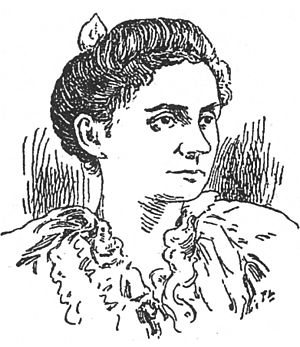Mary Proctor facts for kids
Quick facts for kids
Mary Proctor
|
|
|---|---|

Sketch of Proctor that appeared in The New York Times on September 9, 1894.
|
|
| Born | 1862 |
| Died | September 11, 1957 |
| Parent(s) | Richard A. Proctor Marty Proctor |
Mary Proctor FRAS (1862 – 11 September 1957) was an American writer who made astronomy popular. She wasn't a professional astronomer, but she became famous for her books and articles. She wrote for the general public, especially children. Even though she was often called an American, a passenger list from around 1924 shows she identified as British.
Early Life and Family
Mary Proctor was born in Dublin, Ireland. Her parents were Mary and Richard Proctor. Mary's mother passed away in 1879. Her father remarried in 1881. After that, her family moved to the United States. They settled in Saint Joseph, Missouri, in 1882.
Mary's father was also a well-known British writer and speaker about astronomy. As Mary grew up, she often helped him with his work. She took care of his library and checked his book proofs before they were published. Mary graduated from the London College of Preceptors in 1898.
Two craters are named after the Proctor family. The crater Proctor on the Moon is named after Mary. The crater Proctor on Mars is named after her father.
Career in Astronomy
In 1881, Mary Proctor helped her father start a journal called Knowledge. She wrote several articles for this journal about different myths.
After a successful presentation at the World's Columbian Exposition in 1893, Mary began a career as a speaker on astronomy. Her first book, Stories of Starland (published in 1898), was chosen by the New York City Board of Education for use in schools. She also taught astronomy in private schools while she was studying at Columbia University.
Books and Achievements
Mary Proctor wrote many articles for newspapers and journals. She also published several popular books. Most of her articles and books were for young readers. This earned her the nickname "the children's astronomer." Her books were easy to read, accurate, and full of interesting information. They also had great illustrations.
Many professional astronomers knew and respected Mary Proctor. She became an elected member of the British Astronomical Association in 1897. The next year, in 1898, she joined the American Association for the Advancement of Science. On February 11, 1916, she was chosen as a fellow of the Royal Astronomical Society.
See also
 In Spanish: Mary Proctor para niños
In Spanish: Mary Proctor para niños

